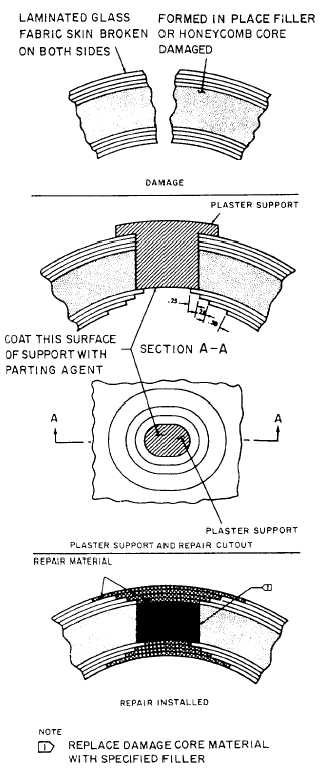Observing Safety Precautions
Figure 14-15.—Foam-type puncture repair.
The following general safety precautions should
be observed when you make repairs to reinforced
plastic components. You should review these safety
precautions before attempting any repairs to
reinforced plastics.
1. Local station safety regulations as to fire and
health hazards must be complied with.
2. All solvents are flammable; therefore, observe
proper handling procedures.
3. Personnel involved in the mixing or handling
of catalyzed resin prior to the curing operations
should wear rubber gloves. After using rubber
gloves, personnel should clean their hands with soap
and water and rinse with vinegar to neutralize any
catalyst particles.
4. Never mix the catalyst and promoter together,
as they are explosively reactive as a mixture. Always
mix the promoter with the resin first, and then add the
catalyst to the mixture.
5. The toxicity of polyester formulation has not
been definitely established. Some of the components
are known to cause nasal or skin irritation to certain
individuals. Adequate ventilation should be provided.
6. The sanding operation on glass cloth
reinforced laminates gives off a fine dust that may
cause skin, eyes, or respiratory irritations. Inhalation
of excessive amounts of this dust should be avoided.
Protection should be provided for respiration, eyes,
and skin.
7. Do not store catalyzed resin in an airtight
container or an unvented refrigerator.
REPAIRING SANDWICH
CONSTRUCTION MATERIALS
The repairs discussed in this section are
applicable to structural-type sandwich construction
consisting of aluminum alloy facings bonded to
aluminum honeycomb and balsa wood cores.
Repairing Minor Surface Damage
The most common types of damage to the surface
are abrasions, scratches, scars, and minor dents.
These minor surface damages require no repair other
than the replacement of the original protective coating
14-13

